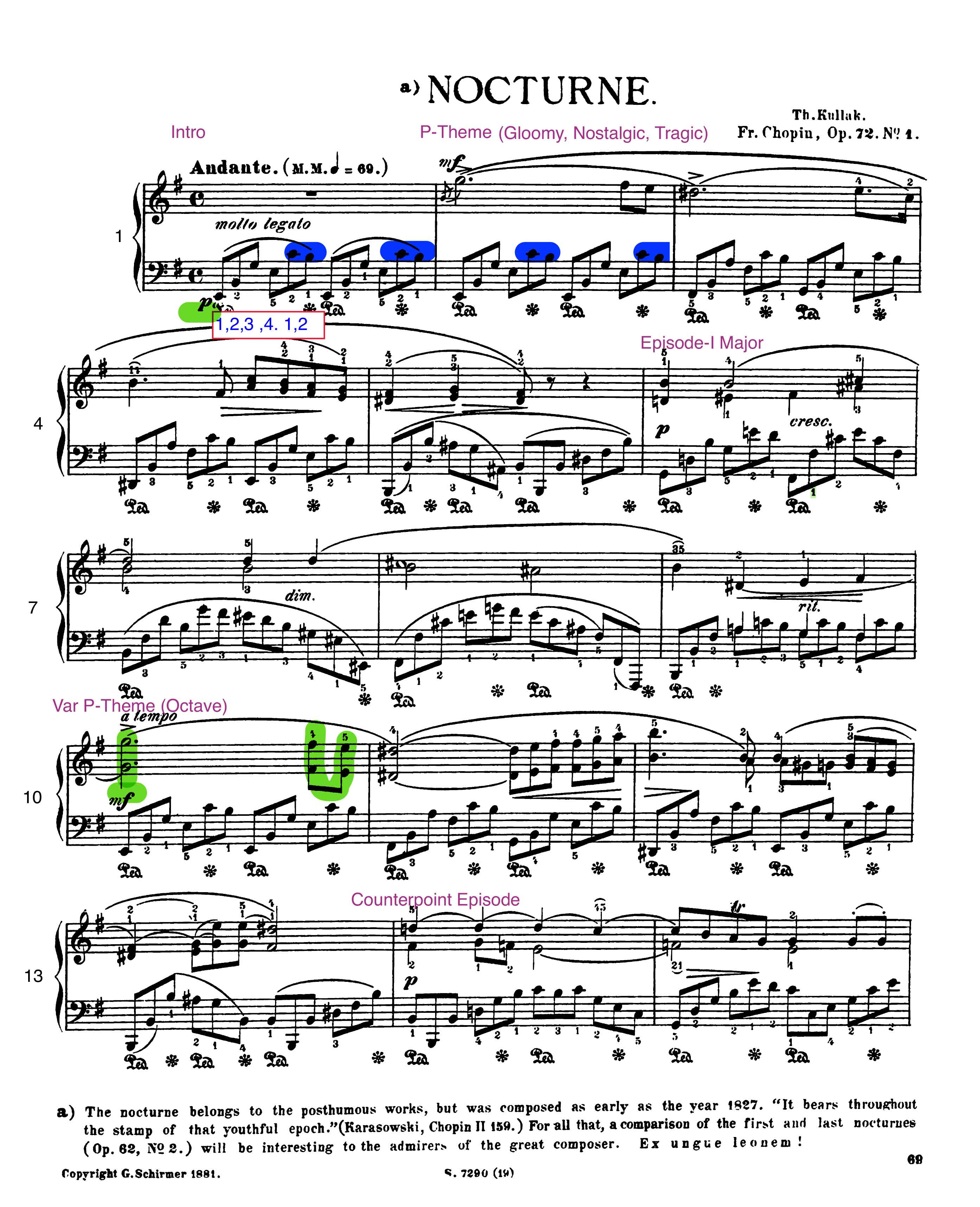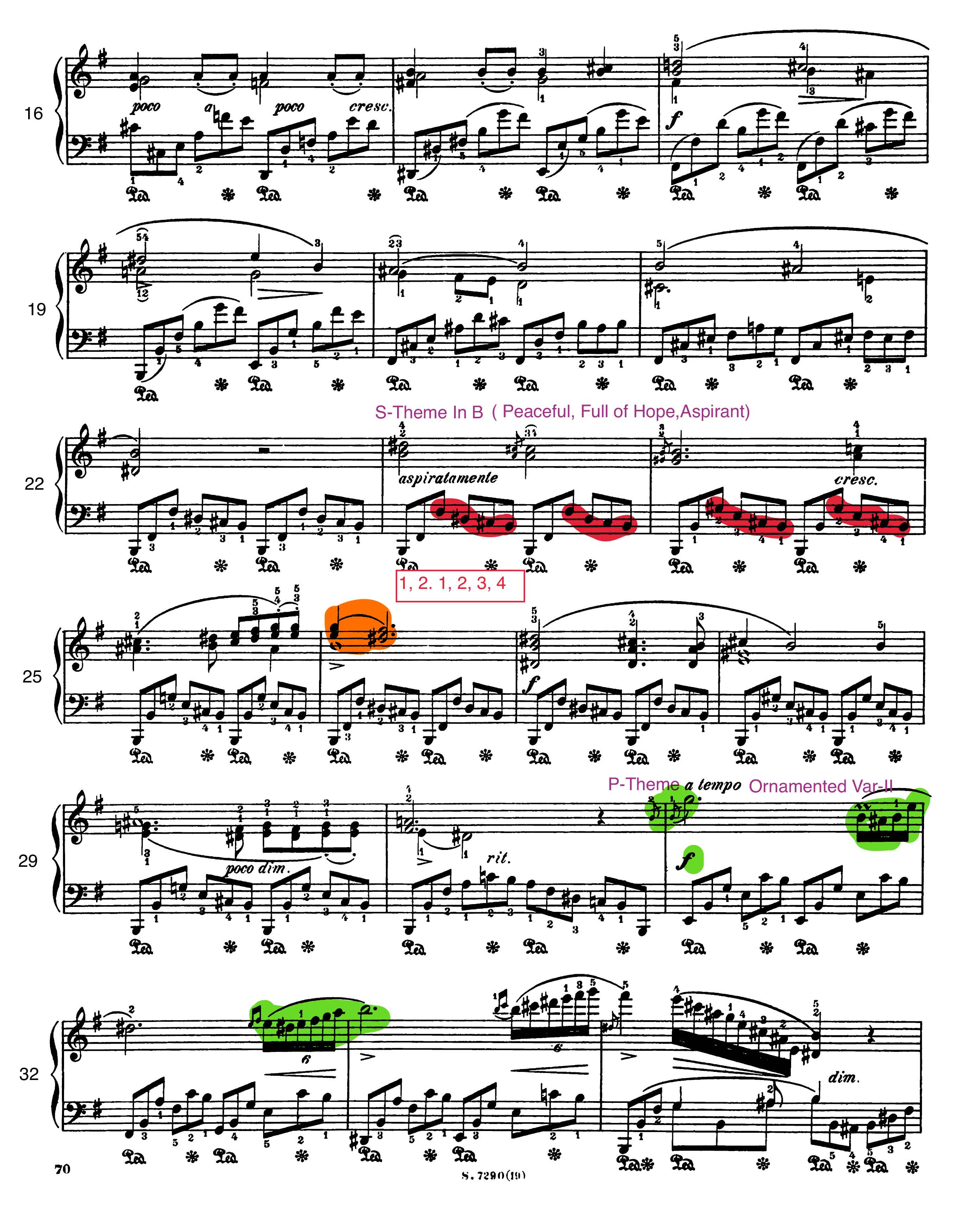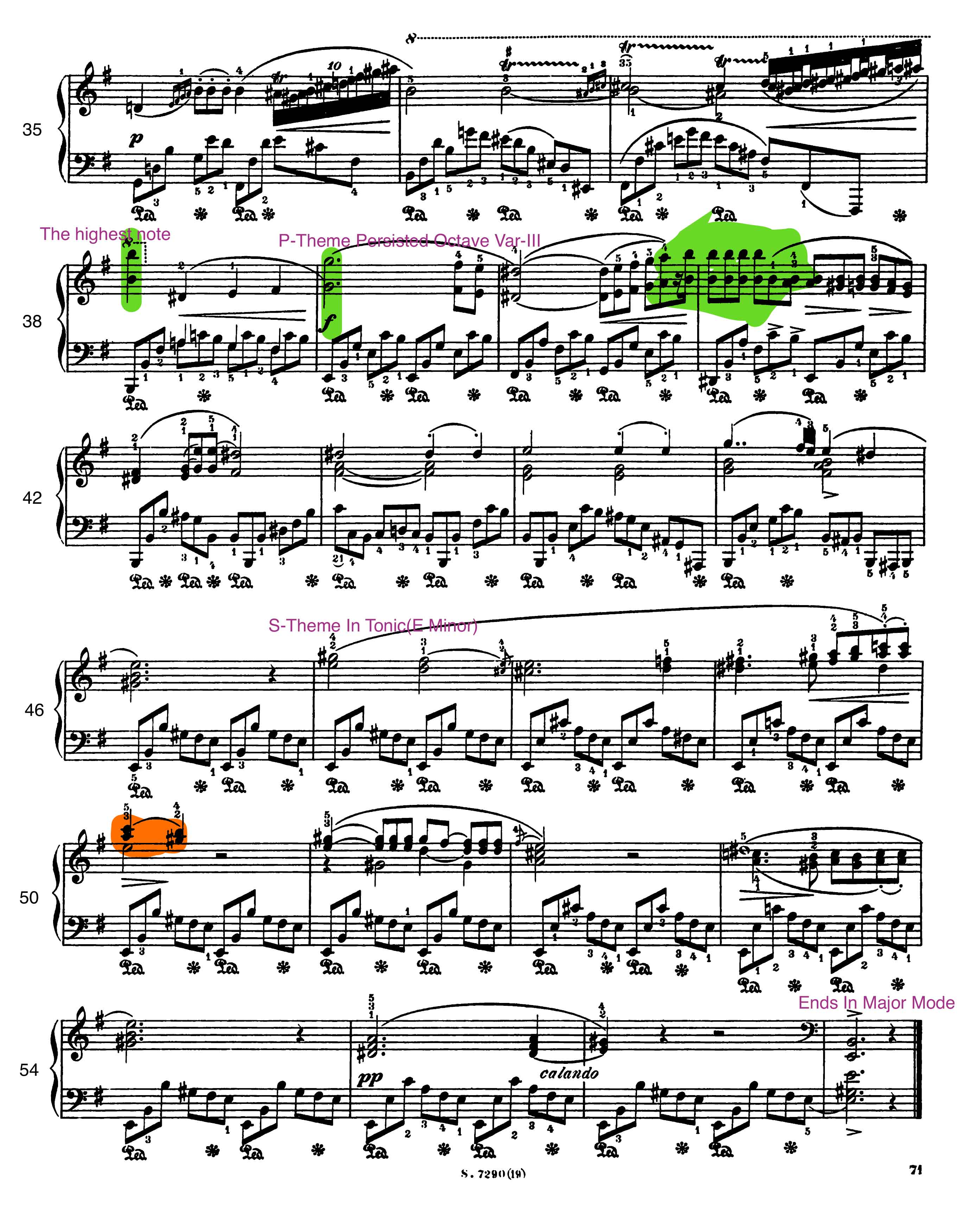Chopin’s Nocturne in E minor Op.72 No.1
Description, Interpretations and, Comparisons
By: Amir Houshangi
University of Montreal
Presented to Professor Jean-François Rivest
As the final assignment of the seminar
MIN 6942-A-A20
The Poetic Approach in the Interpretation
I.Introduction and Description
The Nocturne as a night-piece was introduced and developed as solo piano music by Irish composer John Filed and leading to its notable by Polish composer Frederic Chopin.
Despite the Opus number, Nocturne in E minor is Chopin's first composition of this musical form. Chopin wrote this piece at seventeen in 1827 as his sister's hommage, who passed away in the same year. This Nocturne has the posthumous opus number since it was published in 1855, five years after the composer's death.
At first pace, this article purposes to observe this Nocturne from diverse generative viewpoints and discover the relations between these elements and the poetic aspects.
The second step is to discuss Vladimir Horowitz, Maurizio Pollini and Helene Grimaud's interpretations regarding their poetic approaches.
The last section aims to compare these interpretations from the mentioned perspectives to comprehend this oeuvre and its interpretations.
I.I.Form:
The piece consists of 57 measures and has two contrasting sections A and B, both followed by episodes and a single interlude. The first section in E minor has a tragic and gloomy atmosphere, while the second part, in major mode, is the messenger of hope and aspiration.
(Please refer to the table below and the score for the details).
A | B | A | B'-Coda |
| A: Primary theme in E min: M1-5 Episode 1:M6-9 Var.1 A: M10-13 (Octaves) Ep 2: M14-17 Interlude:M18-22 | Secondary Theme In B Major: Measures 23-30 | Var.2 A: M31- 38 (Ornamented) Var.3 A: M39- 46 (Emphasized Octaves) | Secondary Theme In E Major: Measures 47-54 Codetta: M55-57 |
I.II. Texture, Harmony, Rhythm and Dynamic:
This Nocturne principal characteristic is the repetitive arpeggiated chords in the left hand as the accompaniment line while the right-hand plays the melody line. Although this feature is present throughout the piece, as the episode starts from measure 14, the composer changes the texture by adding an extra melody line and creates contrapuntal quality.
In terms of harmony, there are features in this piece that are considerable regarding the interpretation. For instance, in the minor section, a repetitive pattern that ends with two notes ( c and b), which creates a minor-second interval, plays a substantial role in inducing a sense of sorrow and tension. (Marked in blue in the score measure:1, 2)
In the second triplet, the interval leaping between the fourth and fifth notes divides the triplets into a group of four and two notes. As a result, in terms of articulation and rhythm pattern, the top note (c) sounds accentuated and dissonant, making harmony intriguing. (Marked in blue measure:1,2)
Likewise, the combination of this uneven division in triplets and the melody line emphasizes the sense of uncertainty and melancholy.
On the contrary, In the Major section, the interval leaping between the second and third notes leads us to a different effect. In this case, the division of two ascending and four descending notes inspires a sense of hope and aspiration. (Marked in red measure:23.24)
Regarding harmonic solutions, there are moments in the piece that the composer does not follow the clichés. For example, in measures 21 and 22, he prefers a major chord instead of a minor chord, which the listener expects to hear!
The other considerable harmony subject is two tension/relaxation chords, which the composer emphasizes by adding an accent and dynamic marks.
In measures 26 and 50, the measure's first beat is a minor chord (tensed chord), which solves in a major chord (solved/relaxed chord). These two bars are crucial since they are the B and B' sections' climaxes in dynamic, pitch and registration. (Marked in orange in the score, measures 26,50)
In terms of Dynamics, it is evident that the phrases' energy grows gradually from the beginning and reaches its climax in bars 41 and 42. The principal melody repeats four times throughout the piece; it starts in Piano in bar 1 and reaches to mezzo-forte in bar 10 and forte in bars 31 and 38(also the highest note of the piece is in this bar) to 42. Simultaneously Chopin gradually creates a rugged texture by adding octaves, ornaments and other voice lines;
combining the rising dynamics and the polyphonic texture adds tension into the piece's atmosphere; it begins as weeping turns into mourning and ends as bawling. (Marked in green in the score)
II. Interpretations
II.I. Horowitz, Vladimir: The narrator of a dream
Live Recording, Length of Performance: 4’:50".
As if in this magical performance, Horowitz invites the listener to observe a melancholy dream. Every note in this interpretation has a sense; as he plays each note, he adds a meaningful colour into this beautiful dream.
The performer takes his time and starts the piece as he is whispering into the ears. Every aspect of this performance looks dim initially as he wants to bring this dream from the darkness to the light gradually. He starts playing soft, and his sonority resembles dark colours in the left- hand; on the contrary, when the right-hand start the melody, it is deep and clear as someone sings in the dream.
Horowitz is exceptional when it comes to poetic interpretation. It seems that he enhances the beauty of the piece by paying attention to the details. For instance, each time the interval patterns change in the left-hand arpeggios, he softly changes the articulation like a magician; So the listener notices the change but does not understand what has changed. (Ex. Bars 1.2.3 versus Bars 7,8)
Although his tempo is slower than the indicated tempo in the score, the performance is still flowing. To achieve this, he uses contrasts in the phrasing, dynamics and the unique use of the pedal. These contrasts also give the interpretation a melancholic and gloomy atmosphere.
As the performance goes further, the quality of intonation and clarity rises and reaches its climax in bar 38, which has the highest note of the piece. However, another characteristic of Horowitz interpretation comes to light when, in episode 2, he creates a strange and suspended atmosphere by emphasizing the dissonance notes.
In this performance, Horowitz has two approaches regarding the tonalities. While he utilizes exaggerated contrasts in minor sections to make those sections more dramatic, he plays the major parts stable and calm to creates hopeful images.
In summary and as the conclusion:
In this interpretation, Horowitz's poetic approach is to create a dreamlike mood, full of stunning detailed images containing sorrow, melancholy, also hope, and aspiration.
The principal characteristics of this performance which leads to this poetic interpretation are: 1-His unique articulations 2- delving into the details 3- slower than usual tempi, making the music more dramatic 4- considerable contrasts in different sections 5- utilizing the full range of dynamics and exceptional phrasing.
II.II. Pollini, Maurizio (The images of a story)
Studio Recording, Length of performance, 3’:50".
In this interpretation, the remarkable point is the performer's attention to the piece's structure and the rhetoric.
From the very beginning of the piece, it is as if Pollini intends to tell us a poetic story. One of the essential features of this performance is that the player, like a storyteller, gives us a vibrant image of what will happen next by observing rhetoric principles.
This interpretation is form -oriented, and this gives the listener a separate image for each section. Henceforth it is the audience's imagination that can decide which image to stick the most.
Poetry in this performance is very introverted, as if the performer has the role of messenger.
Pollini here is the custodian of the concealed rhyme in the piece, He tells us this beautiful story with the utmost care, and at every moment, he conveys a delicate message to us.
In summary and as the conclusion:
In my opinion, since the performer modestly respects all the composer's indicated instructions, this performance is perhaps the closest interpretation of Chopin's original poetry.
The principal characteristics of this performance which leads to this poetic interpretation are:
1- Adherence to the original poetic nature of the oeuvre
2- Highlight the value of the piece's form and structure by observing the principles of rhetoric.
3- respect for the value of the indicated instructions and marks by Chopin
4- transparency in articulation and phrasing.
II.III. Grimaud, Hélène (A glorious romance)
The inner spirit of this performance is a combination of poetry and epic. The performance starts with rubato arpeggio, and when the main melody begins to sing, it seems you are a listener of an epic romance poem.
Grimaud, in her interpretation, starts the melody confidently, and the level of the dynamics gradually increasing throughout the piece. She performs even the minor section compelling and, in a heroic manner.
One of the salient features of this performance that has a poetic effect is its arpeggios accentuation. By emphasizing each arpeggio's bass note, Grimaud strengthens the sense of confidence in the audience's mind.
This performance is full of agility and energy; the range of dynamics is always above the mezzo-forte level, even in the beginning. The only part that the performer plays with a soft 9 and smooth sound level is the last section, which creates a beautiful contrast between the ending and the rest of the piece.
This performance's poetic interpretation is accompanied by epic and glorious moments as if the performer is reciting an epic romance poem.
In summary and as the conclusion:
The performance's spirit is extroverted, and Grimaud performs this oeuvre like a modern actor who catches all the attention on stage alone.
The principal characteristics of this performance which leads to this poetic interpretation are:
1- Extroverted and personal approach in terms of the interpretation process.
2- Create a dynamic contrast between the ending and the rest of the piece.
3- Unique articulation and accentuation.
4- A distinct approach that the performer has towards the minor sections of the piece.
III. Comparisons
Poetic Approaches; Narrative, Sense and Imagery
III.I. Horowitz / Pollini:
In terms of narrative approach and moods, Horowitz's interpretation
resembles a melancholic, dreamy ambience, full of details and nuances. In contrast, Pollini's
performance provides an overview of tragic and joyful moments. In Horowitz's performance,
the listener is a part of the dream, while in Pollini's edition, the audience is an observer. With
the utilization of tension and relaxation, little pauses, paying attention to the details, Horowitz
wants to create breathtaking moments. Unlike Horowitz, Pollini wants to deliver the
composer's poetic message.
If we want to examine Horowitz's performance from aesthetic and poetic perspectives, his interpretation is like an expressionist painter. All the components of Horowitz's interpretation capture the listener's attention as of a melancholic dream as if his performance is an amalgam of rain and storm. On the contrary, Pollini's narrative is full of serenity, giving us images and leaving us free to choose.
Poetry is evident in both interpretations; Pollini's narrative is a classic poem, while Horowitz's perspective is like a dreamy poem by Lorca.
III.II. Pollini / Grimaud:
As mentioned before, Pollini's modest approach to the interpretation makes him like a messenger who wants to deliver the composer's message. In contrast, Grimaud consciously wants to add the performer's message throughout the interpretation.
The poetic spirit of these two interpretations is dissimilar. Grimaud's extroverted approach makes her interpretations significant; her narrative, as if a poetic monologue, leads the audience to stand up and cheer. In contrast, Pollini's interpretation forces the audience to revisit the modest images they have seen throughout the performance.
The Colours in Grimaud's interpretation are bright, daring, and straightforward, while Pollini's
perspective reflects the poetic nature of colours as a photorealistic piece of art.
Pollini's interpretation is associated with images and stories; his performance thrills the
audience's sense of sight; however, Grimaud's performance is a narrative of a poem that must
be listened to in every word.
III.III. Grimaud/ Horowitz:
The dream that Horowitz takes us into is full of images, the metaphors filled with nostalgia and melancholy; he brings the audience to their knees with an immense gift of emotion, reverie and poetry. On the other hand, Grimaud's interpretation reminds the audience of a romance and epic poem's candid narrative, with its sorrows and joys.
Horowitz's performance is an amalgam of drops, rain and storm; Grimaud's narrative is as plain as the plain. Horowitz's interpretation is like a childhood dream as if he were exploring the audience's unconscious, while Grimaud's performance belongs to the present; she has a poem that must be uttered in the end.
In Horowitz's interpretation, the audience is at the center of the event. However, in Grimaud's performance, the narrator plays the lead role in terms of sensory examination; this difference gives the audience more freedom in visualization in the face of Horowitz's interpretation.
IV. Conclusion:
All the while I was working on this project, the point that occupied my mind was the power of creation and the endless imagination of man, the common denominator in all the performances that caught my eyes was the desire to make a connection. Different and sometimes contradictory narrations from a piece of fifty-seven bars remind me of Rumi's poem in praise of the human mind when he says: Thou, Brother, you are all mind and thoughts, the rest is flesh and bone.
Bibliography
Springer, Bethany, Nocturne: The Life and Music of Chopin, California University, 2015
Discography
Grimaud, Hélène Piano Recital: - CHOPIN, F, Deutsche Grammophon 2018
Pollini, Maurizio, CHOPIN, F.: Nocturnes Nos. 1-19, DeutscheGrammophon, 2005
Horowitz, Vladimir, CHOPIN, F.: Nocturnes / Mazurkas / Waltzes, Sony Classical,
Brendel, Alfred, Piano Recital: MUSSORGSKY, M.P. M.A., Vox-7203
Ashkenazy, Vladimir, CHOPIN, F.: Nocturnes Nos. 1-21 / Ballades Nos. 1-4, Decca,1997
Marriner, Neville, MOZART, W.A.: Requiem Academy of St. Martin in the Fields Chorus and Orchestra, Decca,
Ensemble MidtVest, MOZART, W.A.: Serenade No. 10, "Gran Partita" DVOŘÁK, A.: Serenade, Naxos 8.573700
Kuchar, Theodore, DVORAK / TCHAIKOVSKY: Serenades for Strings, Amadis, 1994
Annex:


